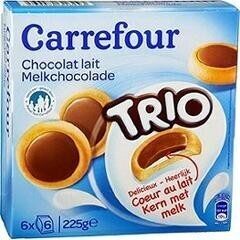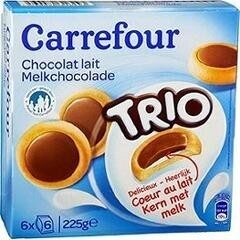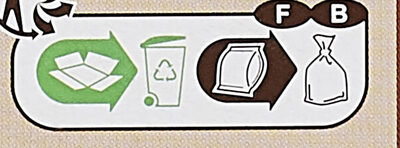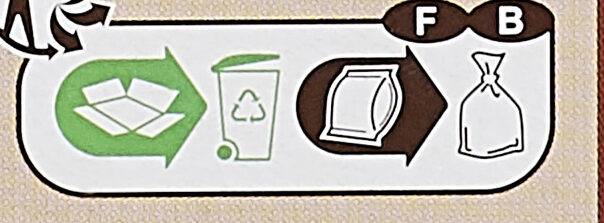Ajuda'ns a fer que la transparència alimentària sigui la norma!
Com a organització sense ànim de lucre, depenem de les vostres donacions per continuar informant els consumidors de tot el món sobre tot allò què mengen.
La revolució alimentària comença amb tu!
Trio Chocolat au lait - Carrefour - 225 g
Trio Chocolat au lait - Carrefour - 225 g
Aquesta pàgina del producte no està completa. Podeu ajudar a completar-la editant-la i afegint-hi més dades a partir de les fotos ja disponibles, o fent-ne més amb l'aplicació de androide o iPhone / iPad. Gràcies!
×
Algunes de les dades d’aquest producte les ha proporcionat directament el fabricant Carrefour.
Codi de barres: 3560070316243 (EAN / EAN-13)
Nom comú: Biscuits nappés de chocolat au lait et fourrage (12.8%) au lait
Quantitat: 225 g
Marques: Carrefour
Categories: Snacks, Aperitius dolços, Galetes i pastissos, Galetes, Galetes de xocolata, en:Filled biscuits, en:Milk chocolate biscuits, en:Biscuit with chocolate covering
Etiquetes, certificacions, premis:
Punt verd, Fet a França, Fet a la UE
Origen del producte i / o dels seus ingredients: Ces mini biscuits sont fabriqués en France à partir de blé français. Le chocolat au lait et le fourrage au lait sont fabriqués en UE.
Origen dels ingredients: França, Unió Europea i no Unió Europea
Productor: Fabriqué en France par EMB 49281 pour Interdis.
Codi de traçabilitat: EMB 49281 - Saint-Georges-des-Gardes (Maine-et-Loire, France)
Botigues: Carrefour, carrefour.fr
Països on es va vendre: França, Grècia, Itàlia, Polònia, Romania, Espanya
Matching with your preferences
Salut
Ingredients
-
27 ingredients
: Farine de blé, chocolat au lait 23% [sucre, beurre de cacao, pâte de cacao, poudre de lait écrémé, lactosérum en poudre, matière grasse de lait anhydre, émulsifiants: polyricinoléate de polyglycérol et lécithines (tournesol), arôme naturel de vanille], sucre, graisse de palme, poudre de lait entier 4,9%, graisse de coprah, sirop de glucose, huile de tournesol, poudre de lait écrémé, lactose, sel, émulsifiant : lécithines (tournesol), poudres à lever: carbonates d'ammonium et carbonates de sodium, arômes.Al·lèrgens: en:Gluten, en:MilkRastres: en:Eggs, en:Nuts
Processament d'aliments
-
Aliments ultra processats
Elements que indiquen que el producte està al grup 4 - Aliments i begudes ultraprocessats:
- Additiu: E322 - Lecitines
- Additiu: E476 - Poliricinoleat de poligliceril
- Ingredient: Emulsionant
- Ingredient: Aromes
- Ingredient: Glucosa
- Ingredient: Xarop de glucosa
- Ingredient: Lactosa
- Ingredient: Sèrum de llet
Els productes alimentaris es classifiquen en 4 grups segons el seu grau de processament:
- Aliments no processats o mínimament processats
- Ingredients culinaris processats
- Aliments processats
- Aliments ultra processats
La determinació del grup es fa en funció de la categoria del producte i dels ingredients que conté.
Additius
-
E322 - Lecitines
Lecithin: Lecithin -UK: , US: , from the Greek lekithos, "egg yolk"- is a generic term to designate any group of yellow-brownish fatty substances occurring in animal and plant tissues, which are amphiphilic – they attract both water and fatty substances -and so are both hydrophilic and lipophilic-, and are used for smoothing food textures, dissolving powders -emulsifying-, homogenizing liquid mixtures, and repelling sticking materials.Lecithins are mixtures of glycerophospholipids including phosphatidylcholine, phosphatidylethanolamine, phosphatidylinositol, phosphatidylserine, and phosphatidic acid.Lecithin was first isolated in 1845 by the French chemist and pharmacist Theodore Gobley. In 1850, he named the phosphatidylcholine lécithine. Gobley originally isolated lecithin from egg yolk—λέκιθος lekithos is "egg yolk" in Ancient Greek—and established the complete chemical formula of phosphatidylcholine in 1874; in between, he had demonstrated the presence of lecithin in a variety of biological matters, including venous blood, in human lungs, bile, human brain tissue, fish eggs, fish roe, and chicken and sheep brain. Lecithin can easily be extracted chemically using solvents such as hexane, ethanol, acetone, petroleum ether, benzene, etc., or extraction can be done mechanically. It is usually available from sources such as soybeans, eggs, milk, marine sources, rapeseed, cottonseed, and sunflower. It has low solubility in water, but is an excellent emulsifier. In aqueous solution, its phospholipids can form either liposomes, bilayer sheets, micelles, or lamellar structures, depending on hydration and temperature. This results in a type of surfactant that usually is classified as amphipathic. Lecithin is sold as a food additive and dietary supplement. In cooking, it is sometimes used as an emulsifier and to prevent sticking, for example in nonstick cooking spray.Origen: Wikipedia (Anglès)
-
E322i - Lecitina
Lecithin: Lecithin -UK: , US: , from the Greek lekithos, "egg yolk"- is a generic term to designate any group of yellow-brownish fatty substances occurring in animal and plant tissues, which are amphiphilic – they attract both water and fatty substances -and so are both hydrophilic and lipophilic-, and are used for smoothing food textures, dissolving powders -emulsifying-, homogenizing liquid mixtures, and repelling sticking materials.Lecithins are mixtures of glycerophospholipids including phosphatidylcholine, phosphatidylethanolamine, phosphatidylinositol, phosphatidylserine, and phosphatidic acid.Lecithin was first isolated in 1845 by the French chemist and pharmacist Theodore Gobley. In 1850, he named the phosphatidylcholine lécithine. Gobley originally isolated lecithin from egg yolk—λέκιθος lekithos is "egg yolk" in Ancient Greek—and established the complete chemical formula of phosphatidylcholine in 1874; in between, he had demonstrated the presence of lecithin in a variety of biological matters, including venous blood, in human lungs, bile, human brain tissue, fish eggs, fish roe, and chicken and sheep brain. Lecithin can easily be extracted chemically using solvents such as hexane, ethanol, acetone, petroleum ether, benzene, etc., or extraction can be done mechanically. It is usually available from sources such as soybeans, eggs, milk, marine sources, rapeseed, cottonseed, and sunflower. It has low solubility in water, but is an excellent emulsifier. In aqueous solution, its phospholipids can form either liposomes, bilayer sheets, micelles, or lamellar structures, depending on hydration and temperature. This results in a type of surfactant that usually is classified as amphipathic. Lecithin is sold as a food additive and dietary supplement. In cooking, it is sometimes used as an emulsifier and to prevent sticking, for example in nonstick cooking spray.Origen: Wikipedia (Anglès)
-
E476 - Poliricinoleat de poligliceril
Polyglycerol polyricinoleate: Polyglycerol polyricinoleate -PGPR-, E476, is an emulsifier made from glycerol and fatty acids -usually from castor bean, but also from soybean oil-. In chocolate, compound chocolate and similar coatings, PGPR is mainly used with another substance like lecithin to reduce viscosity. It is used at low levels -below 0.5%-, and works by decreasing the friction between the solid particles -e.g. cacao, sugar, milk- in molten chocolate, reducing the yield stress so that it flows more easily, approaching the behaviour of a Newtonian fluid. It can also be used as an emulsifier in spreads and in salad dressings, or to improve the texture of baked goods. It is made up of a short chain of glycerol molecules connected by ether bonds, with ricinoleic acid side chains connected by ester bonds. PGPR is a yellowish, viscous liquid, and is strongly lipophilic: it is soluble in fats and oils and insoluble in water and ethanol.Origen: Wikipedia (Anglès)
-
E500 - Carbonats de sodi
Sodium carbonate: Sodium carbonate, Na2CO3, -also known as washing soda, soda ash and soda crystals, and in the monohydrate form as crystal carbonate- is the water-soluble sodium salt of carbonic acid. It most commonly occurs as a crystalline decahydrate, which readily effloresces to form a white powder, the monohydrate. Pure sodium carbonate is a white, odorless powder that is hygroscopic -absorbs moisture from the air-. It has a strongly alkaline taste, and forms a moderately basic solution in water. Sodium carbonate is well known domestically for its everyday use as a water softener. Historically it was extracted from the ashes of plants growing in sodium-rich soils, such as vegetation from the Middle East, kelp from Scotland and seaweed from Spain. Because the ashes of these sodium-rich plants were noticeably different from ashes of timber -used to create potash-, they became known as "soda ash". It is synthetically produced in large quantities from salt -sodium chloride- and limestone by a method known as the Solvay process. The manufacture of glass is one of the most important uses of sodium carbonate. Sodium carbonate acts as a flux for silica, lowering the melting point of the mixture to something achievable without special materials. This "soda glass" is mildly water-soluble, so some calcium carbonate is added to the melt mixture to make the glass produced insoluble. This type of glass is known as soda lime glass: "soda" for the sodium carbonate and "lime" for the calcium carbonate. Soda lime glass has been the most common form of glass for centuries. Sodium carbonate is also used as a relatively strong base in various settings. For example, it is used as a pH regulator to maintain stable alkaline conditions necessary for the action of the majority of photographic film developing agents. It acts as an alkali because when dissolved in water, it dissociates into the weak acid: carbonic acid and the strong alkali: sodium hydroxide. This gives sodium carbonate in solution the ability to attack metals such as aluminium with the release of hydrogen gas.It is a common additive in swimming pools used to raise the pH which can be lowered by chlorine tablets and other additives which contain acids. In cooking, it is sometimes used in place of sodium hydroxide for lyeing, especially with German pretzels and lye rolls. These dishes are treated with a solution of an alkaline substance to change the pH of the surface of the food and improve browning. In taxidermy, sodium carbonate added to boiling water will remove flesh from the bones of animal carcasses for trophy mounting or educational display. In chemistry, it is often used as an electrolyte. Electrolytes are usually salt-based, and sodium carbonate acts as a very good conductor in the process of electrolysis. In addition, unlike chloride ions, which form chlorine gas, carbonate ions are not corrosive to the anodes. It is also used as a primary standard for acid-base titrations because it is solid and air-stable, making it easy to weigh accurately.Origen: Wikipedia (Anglès)
-
E503 - Carbonatos de amonio
Ammonium carbonate: Ammonium carbonate is a salt with the chemical formula -NH4-2CO3. Since it readily degrades to gaseous ammonia and carbon dioxide upon heating, it is used as a leavening agent and also as smelling salt. It is also known as baker's ammonia and was a predecessor to the more modern leavening agents baking soda and baking powder. It is a component of what was formerly known as sal volatile and salt of hartshorn.Origen: Wikipedia (Anglès)
Anàlisi dels ingredients
-
Oli de palma
Ingredients que contenen oli de palma: Greix de palma
-
No és vegà
Ingredients no vegans: Xocolata amb llet, Llet desnatada en pols, Xerigot en pols, Llet sencera en pols, Llet desnatada en pols, Lactosa
-
Es desconeix si és vegetarià
Ingredients no reconeguts: fr:Matière grasse de lait anhydre
-
Detalls de l'anàlisi dels ingredients
: Farine de blé, chocolat au lait 23% (sucre, beurre de cacao, pâte de cacao, poudre de lait écrémé, lactosérum en poudre, matière grasse de lait anhydre, émulsifiants (polyricinoléate de polyglycérol, lécithines de tournesol), arôme naturel de vanille), sucre, graisse de palme, poudre de lait entier 4.9%, graisse de coprah, sirop de glucose, huile de tournesol, poudre de lait écrémé, lactose, sel, émulsifiant (lécithines de tournesol), poudres à lever (carbonates d'ammonium, carbonates de sodium), arômes- Farine de blé -> en:wheat-flour - vegan: yes - vegetarian: yes - ciqual_proxy_food_code: 9410 - percent_min: 23 - percent_max: 62.3
- chocolat au lait -> en:milk-chocolate - vegan: no - vegetarian: yes - ciqual_food_code: 31004 - percent_min: 23 - percent: 23 - percent_max: 23
- sucre -> en:sugar - vegan: yes - vegetarian: yes - ciqual_proxy_food_code: 31016 - percent_min: 2.875 - percent_max: 23
- beurre de cacao -> en:cocoa-butter - vegan: yes - vegetarian: yes - ciqual_food_code: 16030 - percent_min: 0 - percent_max: 11.5
- pâte de cacao -> en:cocoa-paste - vegan: yes - vegetarian: yes - ciqual_proxy_food_code: 16030 - percent_min: 0 - percent_max: 7.66666666666667
- poudre de lait écrémé -> en:skimmed-milk-powder - vegan: no - vegetarian: yes - ciqual_food_code: 19054 - percent_min: 0 - percent_max: 5.75
- lactosérum en poudre -> en:whey-powder - vegan: no - vegetarian: maybe - percent_min: 0 - percent_max: 4.6
- matière grasse de lait anhydre -> fr:matiere-grasse-de-lait-anhydre - percent_min: 0 - percent_max: 3.83333333333333
- émulsifiants -> en:emulsifier - percent_min: 0 - percent_max: 3.28571428571429
- polyricinoléate de polyglycérol -> en:e476 - vegan: yes - vegetarian: yes - percent_min: 0 - percent_max: 3.28571428571429
- lécithines de tournesol -> en:sunflower-lecithin - vegan: yes - vegetarian: yes - percent_min: 0 - percent_max: 1.64285714285714
- arôme naturel de vanille -> en:natural-vanilla-flavouring - vegan: yes - vegetarian: yes - percent_min: 0 - percent_max: 2.875
- sucre -> en:sugar - vegan: yes - vegetarian: yes - ciqual_proxy_food_code: 31016 - percent_min: 4.9 - percent_max: 23
- graisse de palme -> en:palm-fat - vegan: yes - vegetarian: yes - from_palm_oil: yes - ciqual_proxy_food_code: 16129 - percent_min: 4.9 - percent_max: 23
- poudre de lait entier -> en:whole-milk-powder - vegan: no - vegetarian: yes - ciqual_food_code: 19021 - percent_min: 4.9 - percent: 4.9 - percent_max: 4.9
- graisse de coprah -> en:coconut-oil - vegan: yes - vegetarian: yes - from_palm_oil: no - ciqual_food_code: 16040 - percent_min: 0 - percent_max: 4.9
- sirop de glucose -> en:glucose-syrup - vegan: yes - vegetarian: yes - ciqual_proxy_food_code: 31016 - percent_min: 0 - percent_max: 4.9
- huile de tournesol -> en:sunflower-oil - vegan: yes - vegetarian: yes - from_palm_oil: no - ciqual_food_code: 17440 - percent_min: 0 - percent_max: 4.9
- poudre de lait écrémé -> en:skimmed-milk-powder - vegan: no - vegetarian: yes - ciqual_food_code: 19054 - percent_min: 0 - percent_max: 4.9
- lactose -> en:lactose - vegan: no - vegetarian: yes - percent_min: 0 - percent_max: 4.9
- sel -> en:salt - vegan: yes - vegetarian: yes - ciqual_food_code: 11058 - percent_min: 0 - percent_max: 0.59
- émulsifiant -> en:emulsifier - percent_min: 0 - percent_max: 0.59
- lécithines de tournesol -> en:sunflower-lecithin - vegan: yes - vegetarian: yes - percent_min: 0 - percent_max: 0.59
- poudres à lever -> en:raising-agent - percent_min: 0 - percent_max: 0.59
- carbonates d'ammonium -> en:e503 - vegan: yes - vegetarian: yes - percent_min: 0 - percent_max: 0.59
- carbonates de sodium -> en:e500 - vegan: yes - vegetarian: yes - percent_min: 0 - percent_max: 0.295
- arômes -> en:flavouring - vegan: maybe - vegetarian: maybe - percent_min: 0 - percent_max: 0.59
Nutrició
-
Mala qualitat nutricional
⚠ ️Atenció: la quantitat de fruita, verdura i fruits secs no s'especifica a l'etiqueta, s'ha fet una estimació a partir de la llista d'ingredients: 0Aquest producte no es considera una beguda per al càlcul de la Nutri-Score.
Punts positius: 2
- Proteïnes: 4 / 5 (valor: 7.1, valor arrodonit: 7.1)
- Fibra: 2 / 5 (valor: 2, valor arrodonit: 2)
- Fruites, verdures, fruits secs i olis de colza/nou/oliva: 0 / 5 (valor: 0, valor arrodonit: 0)
Punts negatius: 25
- Energia: 6 / 10 (valor: 2105, valor arrodonit: 2105)
- Sucres: 7 / 10 (valor: 34, valor arrodonit: 34)
- Greixos saturats: 10 / 10 (valor: 13, valor arrodonit: 13)
- Sodi: 2 / 10 (valor: 236, valor arrodonit: 236)
Els punts per proteïnes no es compten perquè els punts negatius són més o iguals a 11.
Puntuació nutricional: (25 - 2)
Nutri-Score:
-
Nivells de nutrients
-
Greix en alta quantitat (24%)
Què us cal saber- Un alt consum de greixos, especialment de greixos saturats, pot augmentar el colesterol, que augmenta el risc de patir malalties del cor.
Recomanació: Reduïu el consum de greixos i greixos saturats- Trieu productes amb menys greixos i greixos saturats.
-
Àcid gras saturat en alta quantitat (13%)
Què us cal saber- Un alt consum de greixos, especialment de greixos saturats, pot augmentar el colesterol, que augmenta el risc de patir malalties del cor.
Recomanació: Reduïu el consum de greixos i greixos saturats- Trieu productes amb menys greixos i greixos saturats.
-
Sucre en alta quantitat (34%)
Què us cal saber- Un alt consum de sucre pot provocar augment de pes i càries dental. També augmenta el risc de patir diabetis tipus 2 i malalties cardiovasculars.
Recomanació: Limitau el consum de sucre i de begudes ensucrades- Les begudes ensucrades (com ara refrescos, begudes de fruites i sucs i nèctars de fruites) s'han de limitar tant com sigui possible (no més d'1 got al dia).
- Triau productes amb menor contingut de sucre i reduïu el consum de productes amb sucres afegits.
-
Sal comuna en Quantitat moderada (0.59%)
Què us cal saber- Un alt consum de sal (o sodi) pot provocar un augment de la pressió arterial, que pot augmentar el risc de patir malalties del cor i ictus.
- Moltes persones que tenen hipertensió no ho saben, ja que sovint no en tenen símptomes.
- La majoria de la gent consumeix massa sal (de 9 a 12 grams de mitjana al dia), al voltant del doble del nivell màxim d'ingesta recomanat.
Recomanació: Limitau la ingesta de sal i d'aliments rics en sal- Reduïu la sal que emprau quan cuinau, i no afegiu sal a taula.
- Limiteu el consum d'aperitius salats i trieu productes amb menor contingut de sal.
-
-
Informació nutricional
Informació nutricional Com es ven
per 100 g/100 mlComparat amb: en:Milk chocolate biscuits Energia 2.105 kj
(503 kcal)+1% Greix 24 g +4% Àcid gras saturat 13 g +2% Hidrats de carboni 63 g -2% Sucre 34 g -3% Fiber 2 g -27% Proteïna 7,1 g +10% Sal comuna 0,59 g -1% Fruits‚ vegetables‚ nuts and rapeseed‚ walnut and olive oils (estimate from ingredients list analysis) 0 %
Entorn
-
Eco-puntuació D - Impacte ambiental alt
El Eco-Score és una puntuació experimental que resumeix els impactes ambientals dels productes alimentaris.→ L'Eco-Score es va desenvolupar inicialment a França i s'està ampliant per a altres països europeus. La fórmula Eco-Score està subjecta a canvis, ja que es millora periòdicament per fer-la més precisa i més adequada per a cada país.Anàlisi del cicle de vida
-
Impacte mitjà dels productes de la mateixa categoria: C (Score: 52/100)
Categoria: Biscuit (cookie), chocolate covering
Categoria: Biscuit (cookie), chocolate covering
- Puntuació ambiental PEF ( petjada ambiental de l'aliment ): 0.52 (com més baixa sigui la puntuació, menor serà l'impacte)
- incloent l'impacte sobre el canvi climàtic: 6.74 kg CO₂ eq/kg del producte
Etapa Impacte Agricultura
52.4 %Processament
41.6 %Empaquetament
2.1 %Transport
2.9 %Distribució
0.9 %Consum
0.0 %
Bonificacions i punts negatius
-
Orígens dels ingredients amb impacte mitjà
Bonificació: +3
Política ambiental: 0
Transport: +3
Origen del producte i / o dels seus ingredients % d'ingredients Impacte Unió Europea i no Unió Europea 50 %Alt França 50 %Mitjà
-
Ingredients que amenacen les espècies
Punts negatius: -10
Conté oli de palma
Els boscos tropicals d'Àsia, Àfrica i Amèrica Llatina es destrueixen per crear i ampliar les plantacions de palmera d'oli. La desforestació contribueix al canvi climàtic, i posa en perill espècies com l'orangutan, l'elefant pigmeu i el rinoceront de Sumatra.
-
Embalatge d'impacte mitjà
Punts negatius: -11
Forma Material Reciclatge Impacte 1 Sleeve Cartó Recycle Baix 6 Bag Plàstic Discard Alt
Eco-Score per a aquest producte
-
Impacte per a aquest producte: D (Score: 34/100)
Producte: Trio Chocolat au lait - Carrefour - 225 g
Puntuació de l'anàlisi del cicle de vida: 52
Suma de bonificacions i punts negatius: -18
Puntuació final: 34/100
-
Petjada de carboni
-
Equivalent a conduir 3.5 km en un cotxe de gasolina
674 g de CO² per cada 100 g de producte
La xifra d'emissions de carboni prové de la base de dades Agribalyse d'ADEME, per a la categoria: Biscuit (cookie), chocolate covering (Font: Base de dades ADEME Agribalyse)
Etapa Impacte Agricultura
36.3 %Processament
59.2 %Empaquetament
1.6 %Transport
2.6 %Distribució
0.3 %Consum
0.0 %
Empaquetament
-
Embalatge d'impacte mitjà
-
Peces d'embalatge
1 x Sleeve (Cartó)
6 x Bag (Plàstic)
-
Materials d'embalatge
Material % Pes de l'embalatge Pes de l'embalatge per 100 g de producte Paper or cardboard Plàstic Total
-
Transport
-
Orígens dels ingredients
Orígens dels ingredients amb impacte mitjà
Origen del producte i / o dels seus ingredients % d'ingredients Impacte Unió Europea i no Unió Europea 50 %Alt França 50 %Mitjà
Espècies amenaçades
-
Conté oli de palma
Fomenta la desforestació i amenaça espècies com l'orangutan
Els boscos tropicals d'Àsia, Àfrica i Amèrica Llatina es destrueixen per crear i ampliar les plantacions de palmera d'oli. La desforestació contribueix al canvi climàtic, i posa en perill espècies com l'orangutan, l'elefant pigmeu i el rinoceront de Sumatra.
Altres dades
Altres dades: METTRE JEU Chocolat au lait Fabriqué en France picto 6X 6
Condicions de conservació: À conserver à l'abri de la chaleur et de l'humidité. Pour une dégustation optimale, à consommer de préférence avant le : voir sur le côté du paquet.
Servei al client: Interdis - TSA 91431 - 91343 MASSY Cedex - France
Report a problem
-
Incomplete or incorrect information?
Category, labels, ingredients, allergens, nutritional information, photos etc.
If the information does not match the information on the packaging, please complete or correct it. Open Food Facts is a collaborative database, and every contribution is useful for all.
Fonts de dades
Producte afegit per kiliweb
Última modificació de la pàgina del producte per fabi2.
La pàgina del producte, també editada per carrefour, chevalstar, driveoff, ecoscore-impact-estimator, openfoodfacts-contributors, org-carrefour, roboto-app, rufruf, teolemon, yukafix.












